An Examination of Jack Welch's Leadership and Change Management at GE
VerifiedAdded on 2023/06/04
|7
|1590
|481
Case Study
AI Summary
This case study examines Jack Welch's leadership style during his tenure as CEO of General Electric (GE). Welch, initially dissatisfied with GE's bureaucratic leadership, implemented a transactional leadership style focused on supervision, performance, and organizational development through rewards and punishments. The study highlights Welch's incremental changes, such as the rank and yank policy, Six Sigma, and employee development programs, aimed at eradicating inefficiency and promoting operational improvements. Key characteristics of Welch's leadership included candor, trust-building, clear mission articulation, motivation, and action orientation. The analysis addresses resistance to change, Welch's evolving policies, and the application of Kotter's 8-step model for change management, emphasizing the importance of urgency, vision, and empowerment in achieving organizational goals, which ultimately led to significant profit gains for GE.
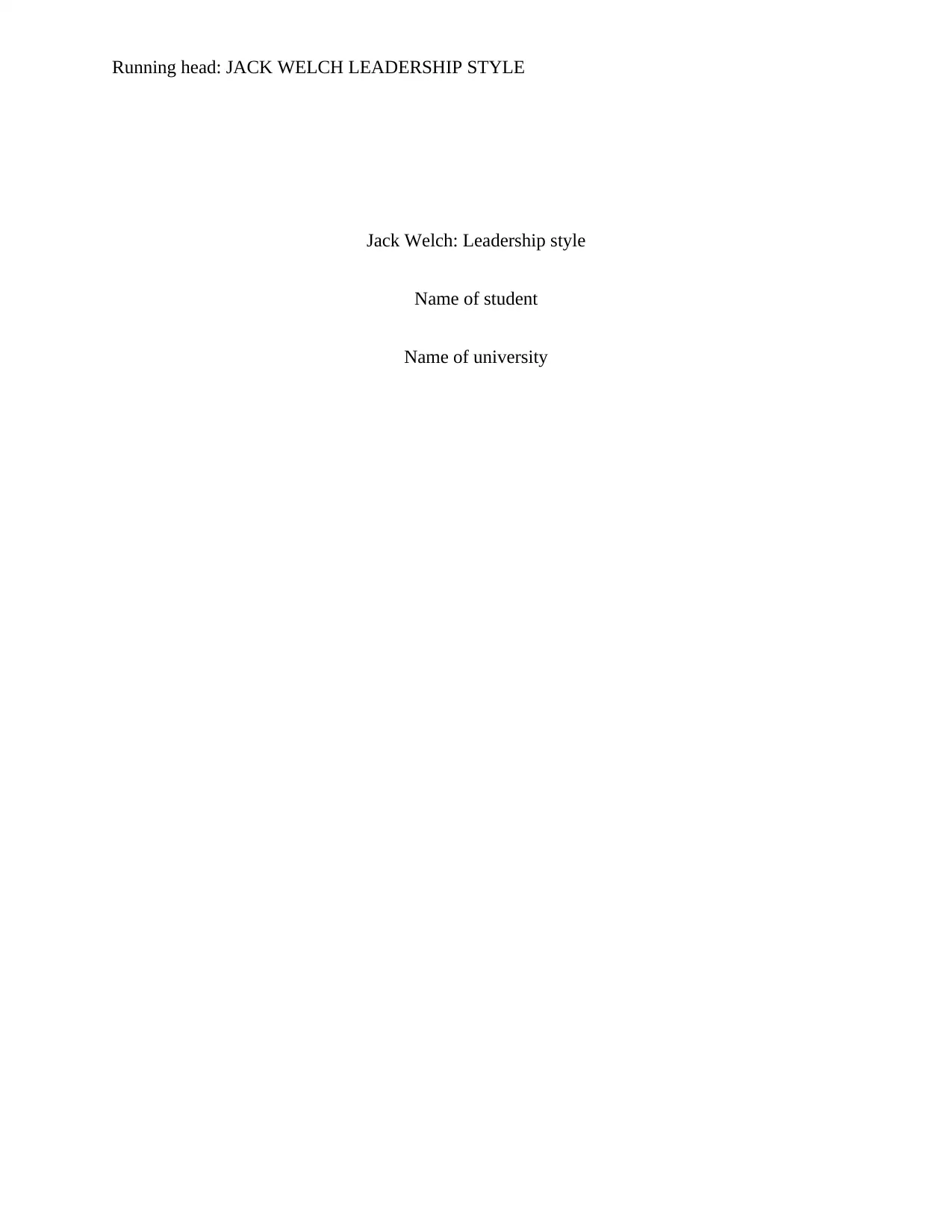
Running head: JACK WELCH LEADERSHIP STYLE
Jack Welch: Leadership style
Name of student
Name of university
Jack Welch: Leadership style
Name of student
Name of university
Paraphrase This Document
Need a fresh take? Get an instant paraphrase of this document with our AI Paraphraser
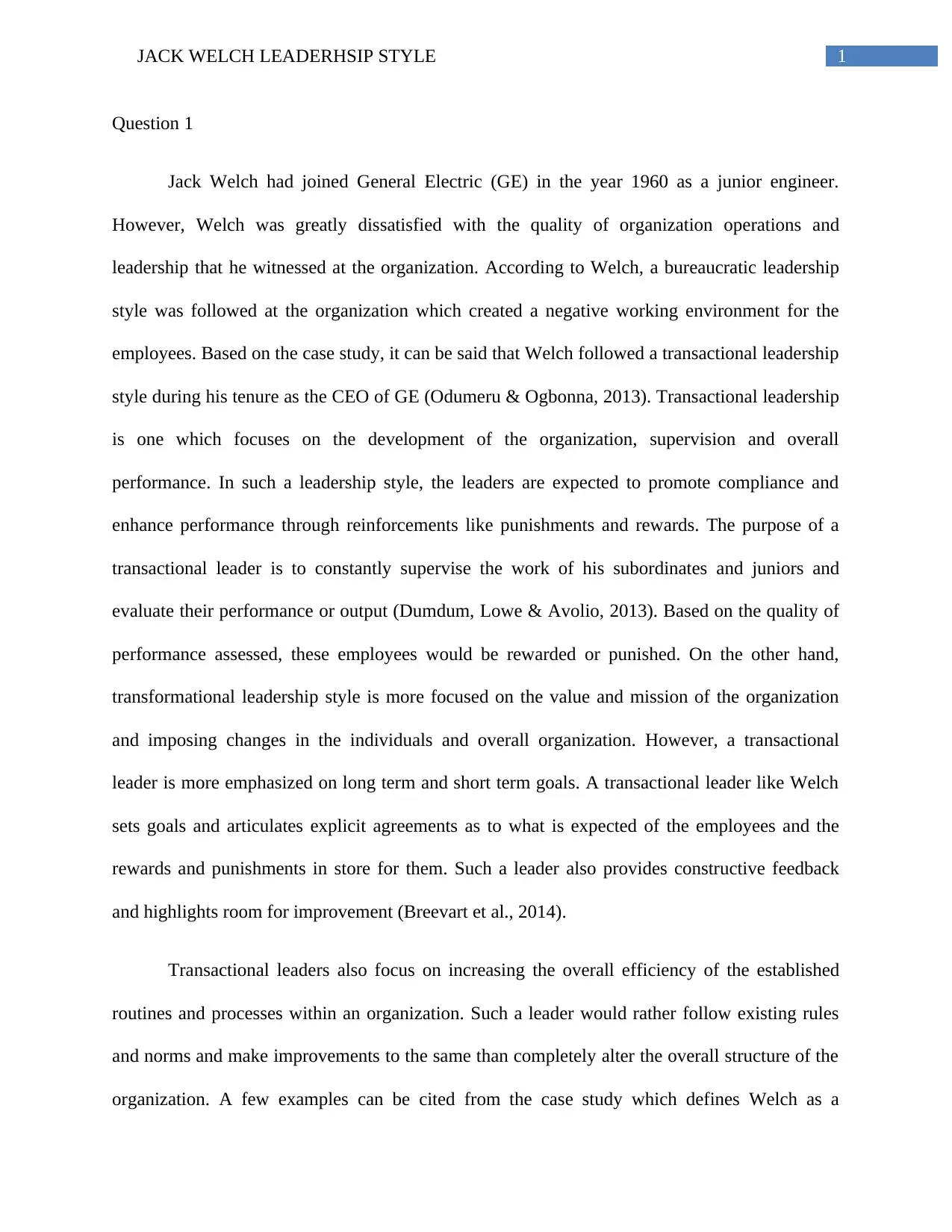
1JACK WELCH LEADERHSIP STYLE
Question 1
Jack Welch had joined General Electric (GE) in the year 1960 as a junior engineer.
However, Welch was greatly dissatisfied with the quality of organization operations and
leadership that he witnessed at the organization. According to Welch, a bureaucratic leadership
style was followed at the organization which created a negative working environment for the
employees. Based on the case study, it can be said that Welch followed a transactional leadership
style during his tenure as the CEO of GE (Odumeru & Ogbonna, 2013). Transactional leadership
is one which focuses on the development of the organization, supervision and overall
performance. In such a leadership style, the leaders are expected to promote compliance and
enhance performance through reinforcements like punishments and rewards. The purpose of a
transactional leader is to constantly supervise the work of his subordinates and juniors and
evaluate their performance or output (Dumdum, Lowe & Avolio, 2013). Based on the quality of
performance assessed, these employees would be rewarded or punished. On the other hand,
transformational leadership style is more focused on the value and mission of the organization
and imposing changes in the individuals and overall organization. However, a transactional
leader is more emphasized on long term and short term goals. A transactional leader like Welch
sets goals and articulates explicit agreements as to what is expected of the employees and the
rewards and punishments in store for them. Such a leader also provides constructive feedback
and highlights room for improvement (Breevart et al., 2014).
Transactional leaders also focus on increasing the overall efficiency of the established
routines and processes within an organization. Such a leader would rather follow existing rules
and norms and make improvements to the same than completely alter the overall structure of the
organization. A few examples can be cited from the case study which defines Welch as a
Question 1
Jack Welch had joined General Electric (GE) in the year 1960 as a junior engineer.
However, Welch was greatly dissatisfied with the quality of organization operations and
leadership that he witnessed at the organization. According to Welch, a bureaucratic leadership
style was followed at the organization which created a negative working environment for the
employees. Based on the case study, it can be said that Welch followed a transactional leadership
style during his tenure as the CEO of GE (Odumeru & Ogbonna, 2013). Transactional leadership
is one which focuses on the development of the organization, supervision and overall
performance. In such a leadership style, the leaders are expected to promote compliance and
enhance performance through reinforcements like punishments and rewards. The purpose of a
transactional leader is to constantly supervise the work of his subordinates and juniors and
evaluate their performance or output (Dumdum, Lowe & Avolio, 2013). Based on the quality of
performance assessed, these employees would be rewarded or punished. On the other hand,
transformational leadership style is more focused on the value and mission of the organization
and imposing changes in the individuals and overall organization. However, a transactional
leader is more emphasized on long term and short term goals. A transactional leader like Welch
sets goals and articulates explicit agreements as to what is expected of the employees and the
rewards and punishments in store for them. Such a leader also provides constructive feedback
and highlights room for improvement (Breevart et al., 2014).
Transactional leaders also focus on increasing the overall efficiency of the established
routines and processes within an organization. Such a leader would rather follow existing rules
and norms and make improvements to the same than completely alter the overall structure of the
organization. A few examples can be cited from the case study which defines Welch as a
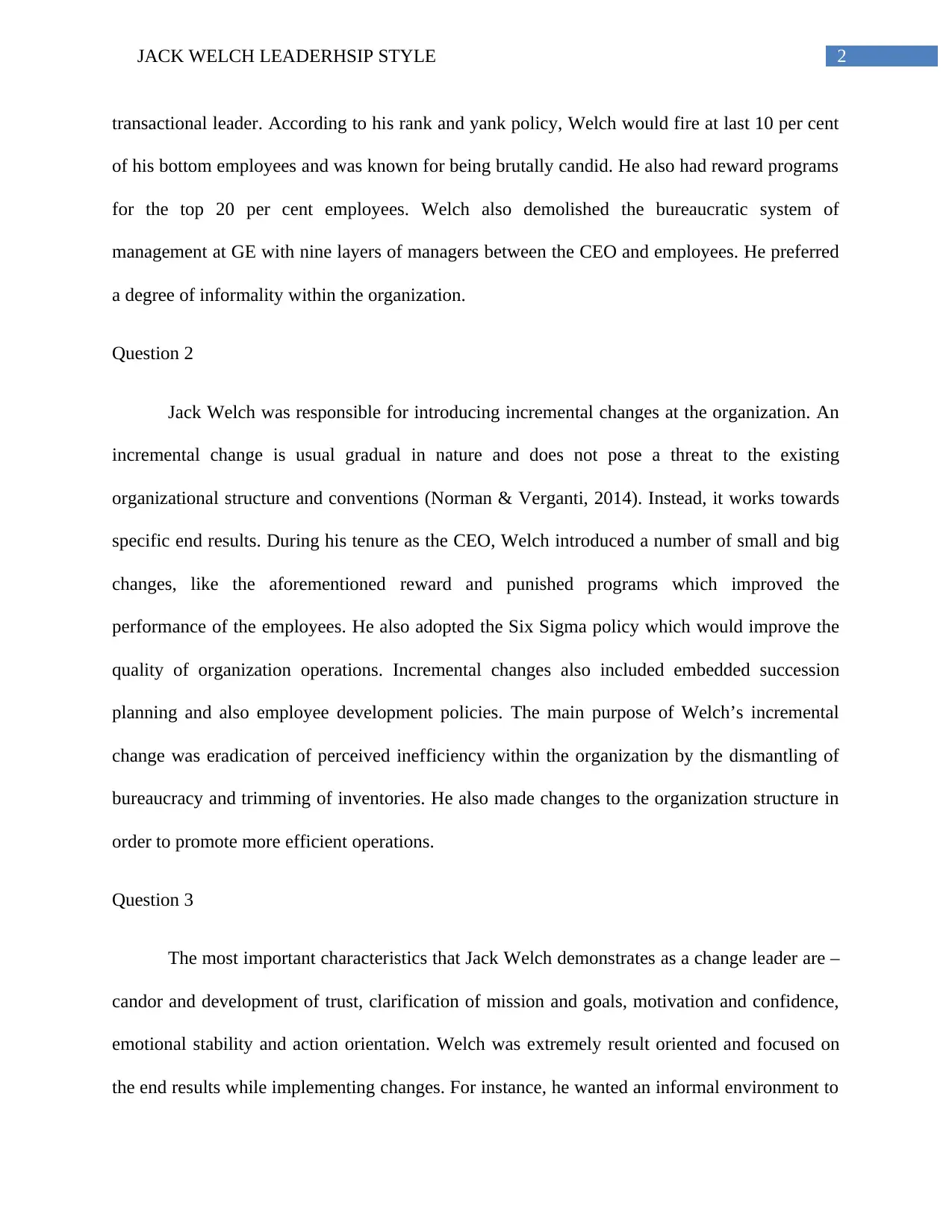
2JACK WELCH LEADERHSIP STYLE
transactional leader. According to his rank and yank policy, Welch would fire at last 10 per cent
of his bottom employees and was known for being brutally candid. He also had reward programs
for the top 20 per cent employees. Welch also demolished the bureaucratic system of
management at GE with nine layers of managers between the CEO and employees. He preferred
a degree of informality within the organization.
Question 2
Jack Welch was responsible for introducing incremental changes at the organization. An
incremental change is usual gradual in nature and does not pose a threat to the existing
organizational structure and conventions (Norman & Verganti, 2014). Instead, it works towards
specific end results. During his tenure as the CEO, Welch introduced a number of small and big
changes, like the aforementioned reward and punished programs which improved the
performance of the employees. He also adopted the Six Sigma policy which would improve the
quality of organization operations. Incremental changes also included embedded succession
planning and also employee development policies. The main purpose of Welch’s incremental
change was eradication of perceived inefficiency within the organization by the dismantling of
bureaucracy and trimming of inventories. He also made changes to the organization structure in
order to promote more efficient operations.
Question 3
The most important characteristics that Jack Welch demonstrates as a change leader are –
candor and development of trust, clarification of mission and goals, motivation and confidence,
emotional stability and action orientation. Welch was extremely result oriented and focused on
the end results while implementing changes. For instance, he wanted an informal environment to
transactional leader. According to his rank and yank policy, Welch would fire at last 10 per cent
of his bottom employees and was known for being brutally candid. He also had reward programs
for the top 20 per cent employees. Welch also demolished the bureaucratic system of
management at GE with nine layers of managers between the CEO and employees. He preferred
a degree of informality within the organization.
Question 2
Jack Welch was responsible for introducing incremental changes at the organization. An
incremental change is usual gradual in nature and does not pose a threat to the existing
organizational structure and conventions (Norman & Verganti, 2014). Instead, it works towards
specific end results. During his tenure as the CEO, Welch introduced a number of small and big
changes, like the aforementioned reward and punished programs which improved the
performance of the employees. He also adopted the Six Sigma policy which would improve the
quality of organization operations. Incremental changes also included embedded succession
planning and also employee development policies. The main purpose of Welch’s incremental
change was eradication of perceived inefficiency within the organization by the dismantling of
bureaucracy and trimming of inventories. He also made changes to the organization structure in
order to promote more efficient operations.
Question 3
The most important characteristics that Jack Welch demonstrates as a change leader are –
candor and development of trust, clarification of mission and goals, motivation and confidence,
emotional stability and action orientation. Welch was extremely result oriented and focused on
the end results while implementing changes. For instance, he wanted an informal environment to
⊘ This is a preview!⊘
Do you want full access?
Subscribe today to unlock all pages.

Trusted by 1+ million students worldwide
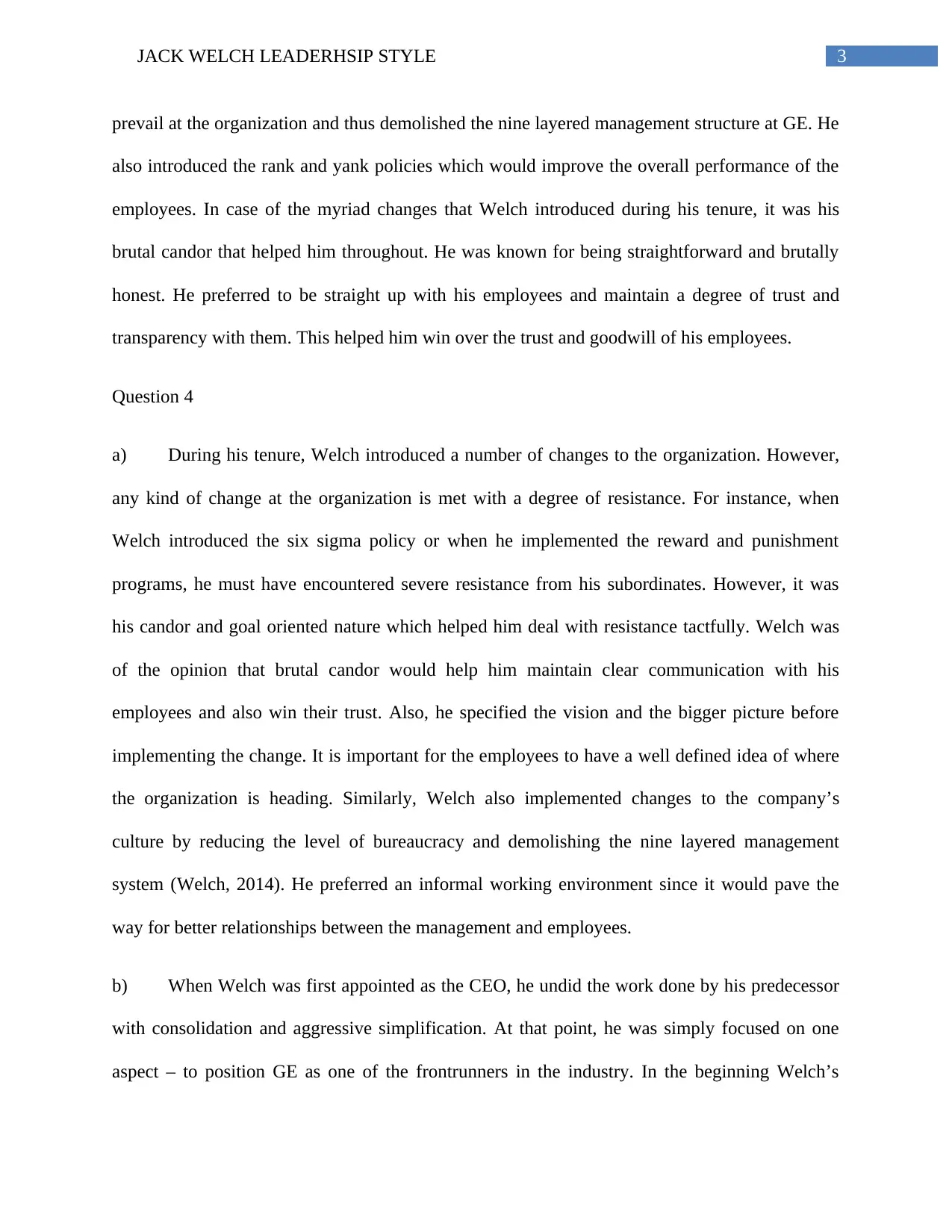
3JACK WELCH LEADERHSIP STYLE
prevail at the organization and thus demolished the nine layered management structure at GE. He
also introduced the rank and yank policies which would improve the overall performance of the
employees. In case of the myriad changes that Welch introduced during his tenure, it was his
brutal candor that helped him throughout. He was known for being straightforward and brutally
honest. He preferred to be straight up with his employees and maintain a degree of trust and
transparency with them. This helped him win over the trust and goodwill of his employees.
Question 4
a) During his tenure, Welch introduced a number of changes to the organization. However,
any kind of change at the organization is met with a degree of resistance. For instance, when
Welch introduced the six sigma policy or when he implemented the reward and punishment
programs, he must have encountered severe resistance from his subordinates. However, it was
his candor and goal oriented nature which helped him deal with resistance tactfully. Welch was
of the opinion that brutal candor would help him maintain clear communication with his
employees and also win their trust. Also, he specified the vision and the bigger picture before
implementing the change. It is important for the employees to have a well defined idea of where
the organization is heading. Similarly, Welch also implemented changes to the company’s
culture by reducing the level of bureaucracy and demolishing the nine layered management
system (Welch, 2014). He preferred an informal working environment since it would pave the
way for better relationships between the management and employees.
b) When Welch was first appointed as the CEO, he undid the work done by his predecessor
with consolidation and aggressive simplification. At that point, he was simply focused on one
aspect – to position GE as one of the frontrunners in the industry. In the beginning Welch’s
prevail at the organization and thus demolished the nine layered management structure at GE. He
also introduced the rank and yank policies which would improve the overall performance of the
employees. In case of the myriad changes that Welch introduced during his tenure, it was his
brutal candor that helped him throughout. He was known for being straightforward and brutally
honest. He preferred to be straight up with his employees and maintain a degree of trust and
transparency with them. This helped him win over the trust and goodwill of his employees.
Question 4
a) During his tenure, Welch introduced a number of changes to the organization. However,
any kind of change at the organization is met with a degree of resistance. For instance, when
Welch introduced the six sigma policy or when he implemented the reward and punishment
programs, he must have encountered severe resistance from his subordinates. However, it was
his candor and goal oriented nature which helped him deal with resistance tactfully. Welch was
of the opinion that brutal candor would help him maintain clear communication with his
employees and also win their trust. Also, he specified the vision and the bigger picture before
implementing the change. It is important for the employees to have a well defined idea of where
the organization is heading. Similarly, Welch also implemented changes to the company’s
culture by reducing the level of bureaucracy and demolishing the nine layered management
system (Welch, 2014). He preferred an informal working environment since it would pave the
way for better relationships between the management and employees.
b) When Welch was first appointed as the CEO, he undid the work done by his predecessor
with consolidation and aggressive simplification. At that point, he was simply focused on one
aspect – to position GE as one of the frontrunners in the industry. In the beginning Welch’s
Paraphrase This Document
Need a fresh take? Get an instant paraphrase of this document with our AI Paraphraser
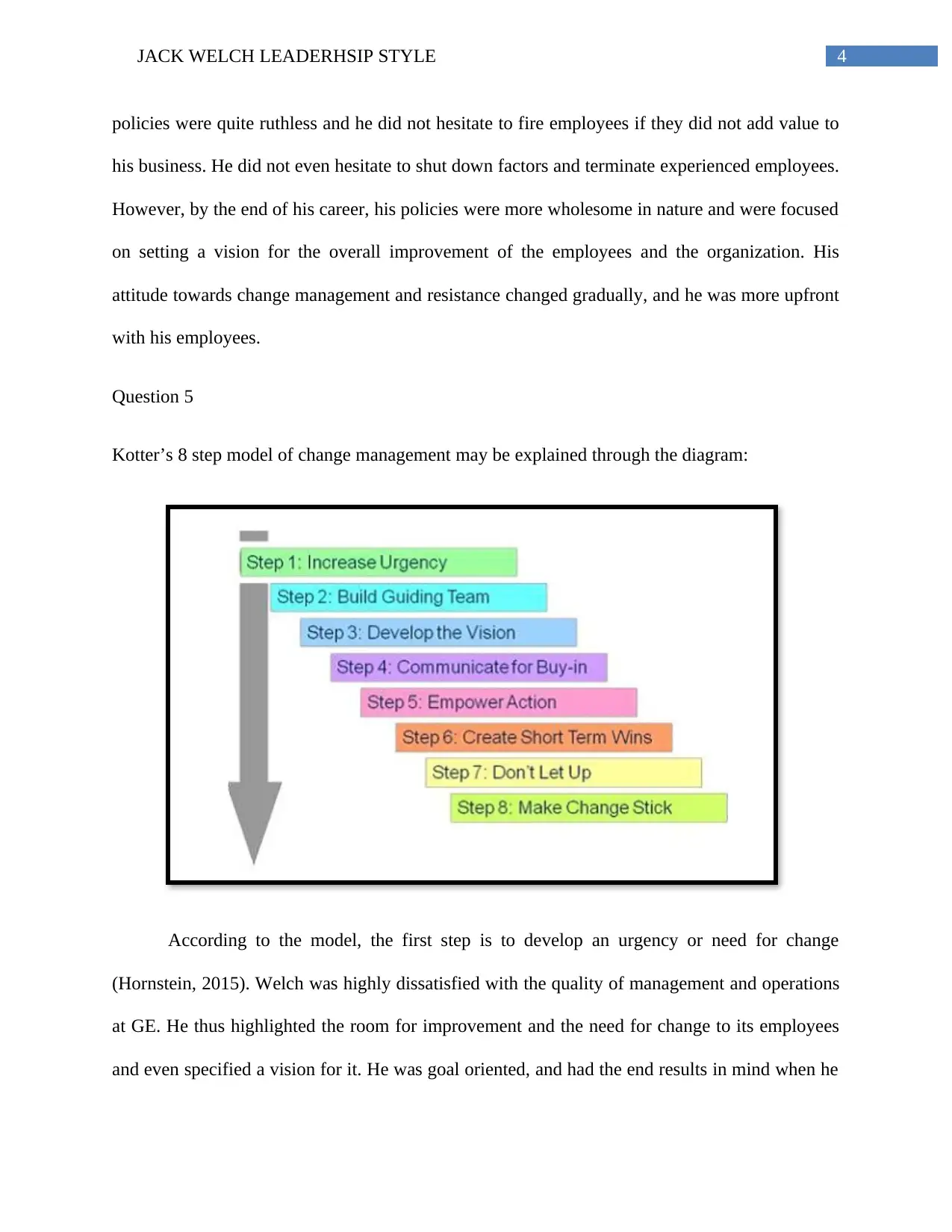
4JACK WELCH LEADERHSIP STYLE
policies were quite ruthless and he did not hesitate to fire employees if they did not add value to
his business. He did not even hesitate to shut down factors and terminate experienced employees.
However, by the end of his career, his policies were more wholesome in nature and were focused
on setting a vision for the overall improvement of the employees and the organization. His
attitude towards change management and resistance changed gradually, and he was more upfront
with his employees.
Question 5
Kotter’s 8 step model of change management may be explained through the diagram:
According to the model, the first step is to develop an urgency or need for change
(Hornstein, 2015). Welch was highly dissatisfied with the quality of management and operations
at GE. He thus highlighted the room for improvement and the need for change to its employees
and even specified a vision for it. He was goal oriented, and had the end results in mind when he
policies were quite ruthless and he did not hesitate to fire employees if they did not add value to
his business. He did not even hesitate to shut down factors and terminate experienced employees.
However, by the end of his career, his policies were more wholesome in nature and were focused
on setting a vision for the overall improvement of the employees and the organization. His
attitude towards change management and resistance changed gradually, and he was more upfront
with his employees.
Question 5
Kotter’s 8 step model of change management may be explained through the diagram:
According to the model, the first step is to develop an urgency or need for change
(Hornstein, 2015). Welch was highly dissatisfied with the quality of management and operations
at GE. He thus highlighted the room for improvement and the need for change to its employees
and even specified a vision for it. He was goal oriented, and had the end results in mind when he
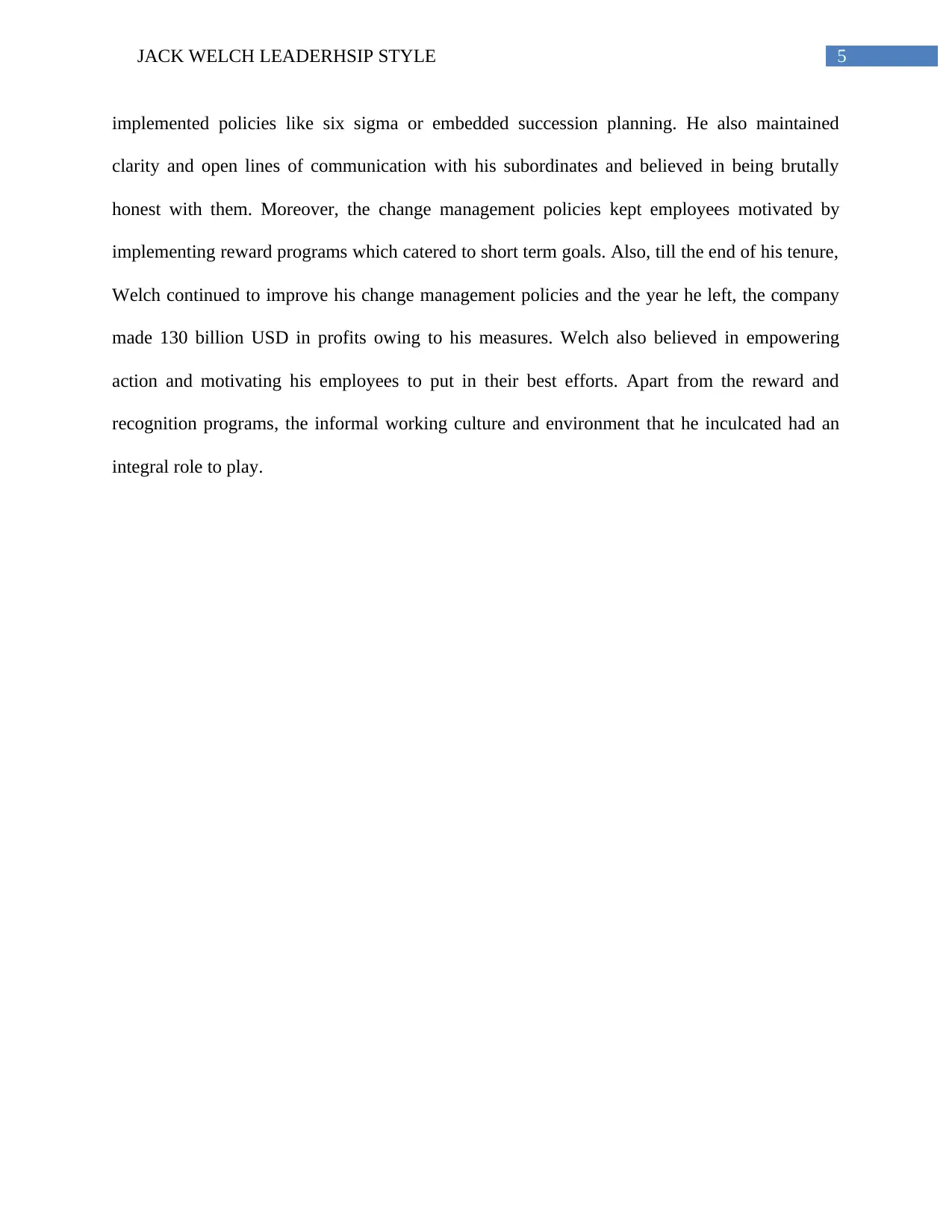
5JACK WELCH LEADERHSIP STYLE
implemented policies like six sigma or embedded succession planning. He also maintained
clarity and open lines of communication with his subordinates and believed in being brutally
honest with them. Moreover, the change management policies kept employees motivated by
implementing reward programs which catered to short term goals. Also, till the end of his tenure,
Welch continued to improve his change management policies and the year he left, the company
made 130 billion USD in profits owing to his measures. Welch also believed in empowering
action and motivating his employees to put in their best efforts. Apart from the reward and
recognition programs, the informal working culture and environment that he inculcated had an
integral role to play.
implemented policies like six sigma or embedded succession planning. He also maintained
clarity and open lines of communication with his subordinates and believed in being brutally
honest with them. Moreover, the change management policies kept employees motivated by
implementing reward programs which catered to short term goals. Also, till the end of his tenure,
Welch continued to improve his change management policies and the year he left, the company
made 130 billion USD in profits owing to his measures. Welch also believed in empowering
action and motivating his employees to put in their best efforts. Apart from the reward and
recognition programs, the informal working culture and environment that he inculcated had an
integral role to play.
⊘ This is a preview!⊘
Do you want full access?
Subscribe today to unlock all pages.

Trusted by 1+ million students worldwide
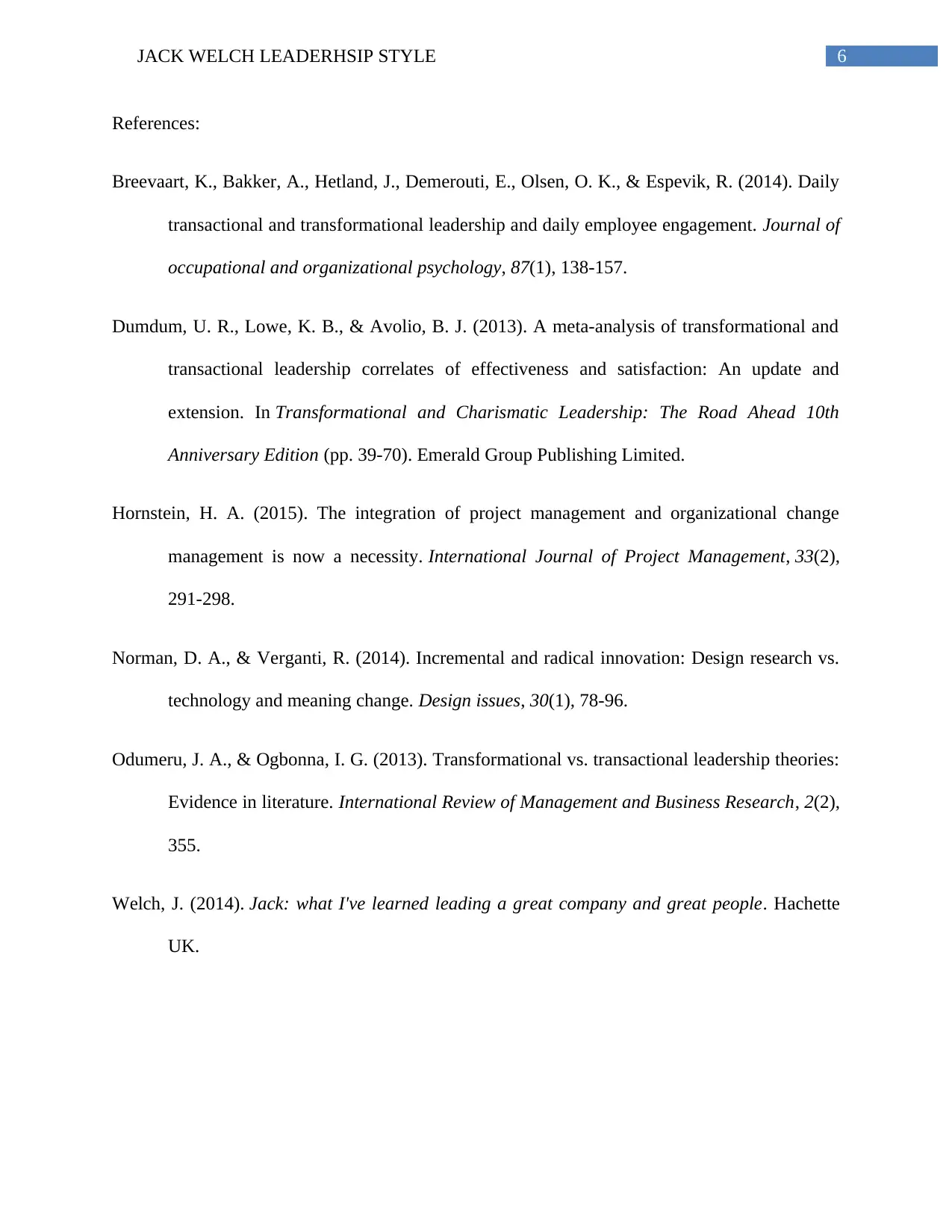
6JACK WELCH LEADERHSIP STYLE
References:
Breevaart, K., Bakker, A., Hetland, J., Demerouti, E., Olsen, O. K., & Espevik, R. (2014). Daily
transactional and transformational leadership and daily employee engagement. Journal of
occupational and organizational psychology, 87(1), 138-157.
Dumdum, U. R., Lowe, K. B., & Avolio, B. J. (2013). A meta-analysis of transformational and
transactional leadership correlates of effectiveness and satisfaction: An update and
extension. In Transformational and Charismatic Leadership: The Road Ahead 10th
Anniversary Edition (pp. 39-70). Emerald Group Publishing Limited.
Hornstein, H. A. (2015). The integration of project management and organizational change
management is now a necessity. International Journal of Project Management, 33(2),
291-298.
Norman, D. A., & Verganti, R. (2014). Incremental and radical innovation: Design research vs.
technology and meaning change. Design issues, 30(1), 78-96.
Odumeru, J. A., & Ogbonna, I. G. (2013). Transformational vs. transactional leadership theories:
Evidence in literature. International Review of Management and Business Research, 2(2),
355.
Welch, J. (2014). Jack: what I've learned leading a great company and great people. Hachette
UK.
References:
Breevaart, K., Bakker, A., Hetland, J., Demerouti, E., Olsen, O. K., & Espevik, R. (2014). Daily
transactional and transformational leadership and daily employee engagement. Journal of
occupational and organizational psychology, 87(1), 138-157.
Dumdum, U. R., Lowe, K. B., & Avolio, B. J. (2013). A meta-analysis of transformational and
transactional leadership correlates of effectiveness and satisfaction: An update and
extension. In Transformational and Charismatic Leadership: The Road Ahead 10th
Anniversary Edition (pp. 39-70). Emerald Group Publishing Limited.
Hornstein, H. A. (2015). The integration of project management and organizational change
management is now a necessity. International Journal of Project Management, 33(2),
291-298.
Norman, D. A., & Verganti, R. (2014). Incremental and radical innovation: Design research vs.
technology and meaning change. Design issues, 30(1), 78-96.
Odumeru, J. A., & Ogbonna, I. G. (2013). Transformational vs. transactional leadership theories:
Evidence in literature. International Review of Management and Business Research, 2(2),
355.
Welch, J. (2014). Jack: what I've learned leading a great company and great people. Hachette
UK.
1 out of 7
Related Documents
Your All-in-One AI-Powered Toolkit for Academic Success.
+13062052269
info@desklib.com
Available 24*7 on WhatsApp / Email
![[object Object]](/_next/static/media/star-bottom.7253800d.svg)
Unlock your academic potential
Copyright © 2020–2025 A2Z Services. All Rights Reserved. Developed and managed by ZUCOL.





